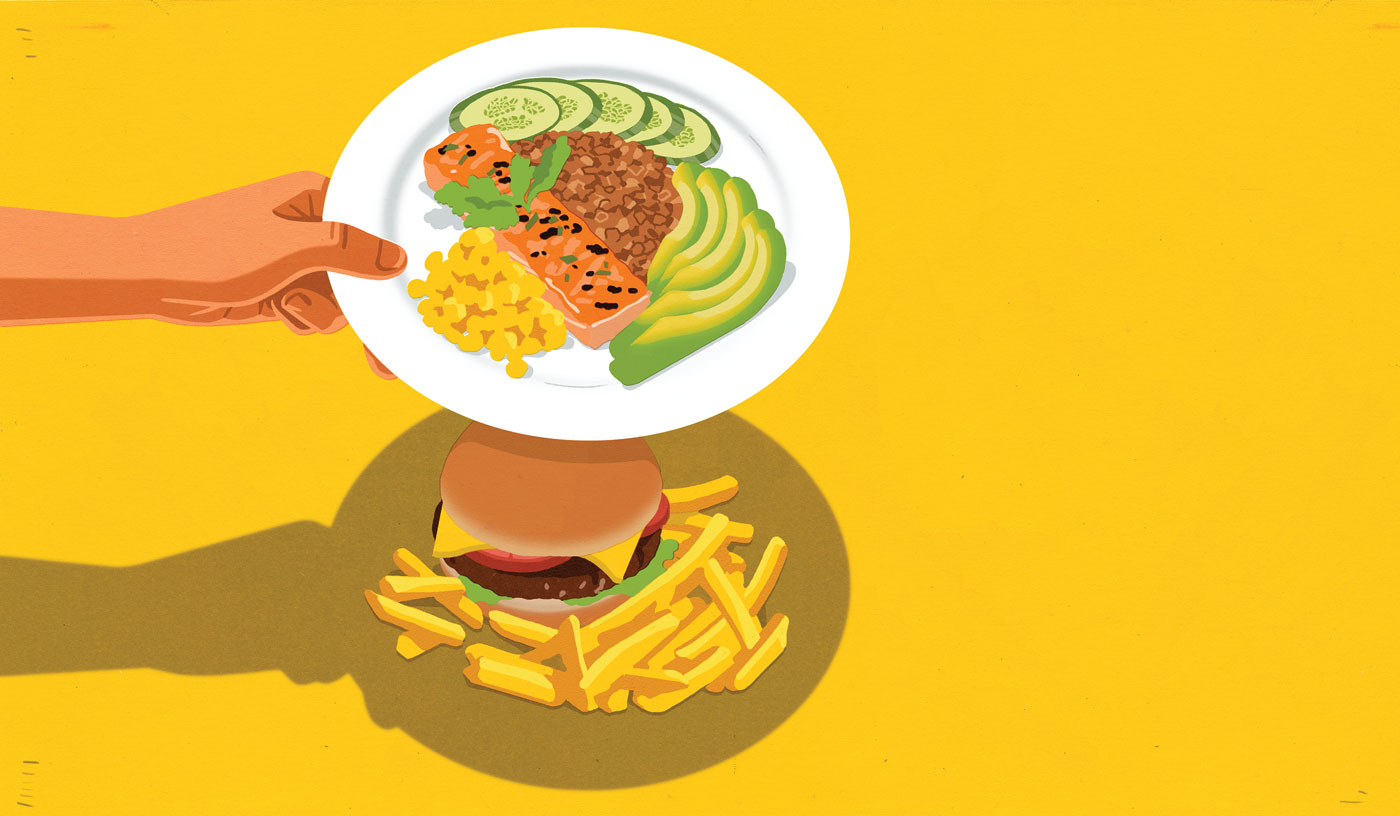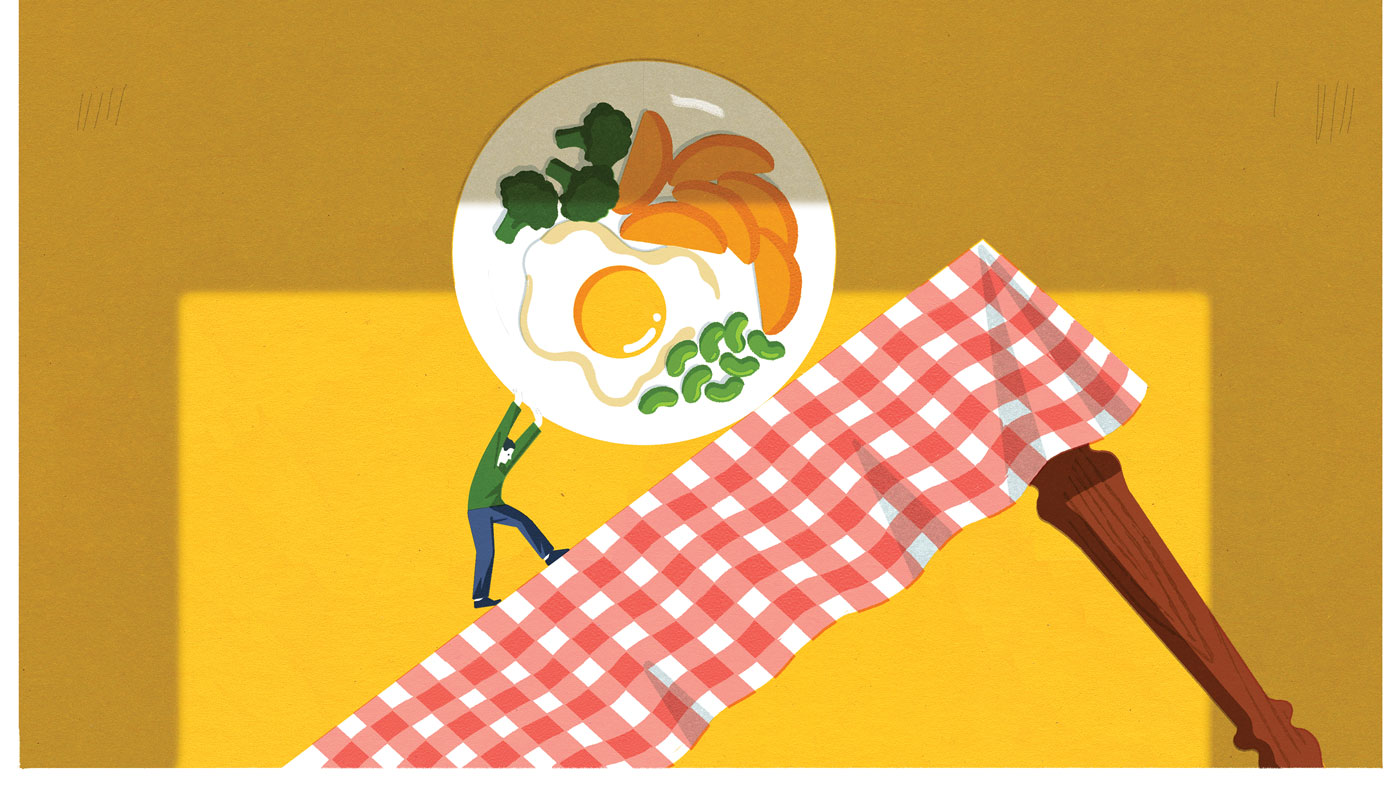
In the season of giving, doing a good deed couldn’t be easier — just pop a few non-perishable items into a food bin. Ease and convenience for donors doesn’t necessarily translate into the best supports for those in need, however. Consider those well-meaning boxes of Kraft Dinner. Without milk and butter, what use are they?
“Together, we fight hunger and its root causes because no one should go hungry,” reads a tagline on the Calgary Food Bank’s website. Then, on the programs page: “The Calgary Food Bank is the city’s main charitable food hub and the first line of support for anyone facing a food emergency.” Food insecurity is not always an emergency, though, and hampers don’t address root causes. According to Dr. Dana Olstad, a registered dietician and public-health nutrition expert, “the root problem is not a food problem, it’s an income problem.”
Temporary or not, food-insecure Calgarians do need food to eat today. So, in the absence of a long-term solution, organizations are shifting to better address one of the primary shortcomings of the food-bank model: dignity. According to Bethany Ross, executive director of Brown Bagging for Calgary’s Kids (BB4CK), charitable organizations tend to be prescriptive and assume they know best how to address other people’s needs — an assumption that undermines their clients’ sense of dignity.
An example of this mindset is the long-held belief that poor nutrition is caused by a lack of knowledge and skills to prepare healthy meals. “If people [buy] less-healthy foods, it’s not because they want to eat unhealthily — it’s by necessity, and because they’re trying to get enough calories to survive,” says Olstad, who is also an assistant professor in the Department of Community Health Sciences at the University of Calgary and an adjunct professor in the School of Public Health at the University of Alberta.
According to a 2021 report produced by the Canadian Poverty Institute and Vibrant Communities Calgary, a non-profit arm of the City of Calgary, food-assistance users need access to no-strings-attached free or affordable food that includes a variety of fresh produce and meat choices. But unfettered access remains a gap in the system, notes Kate Stenson, executive director of the Hillhurst-Sunnyside Community Association (HSCA) and staunch advocate for food security in Calgary.
“It is easier to get [government] funding to run programming like a community garden or community kitchen, than it is to get funding to give people food,” Stenson says. “Those activities are great for community-building, but they’re not single-handedly going to solve food insecurity. People just need money so they can buy food.”

Food insecurity — in essence, not knowing where your next meal will come from — is a growing problem that, in 2020, affected one in five Calgarians. Those most likely to be experiencing food insecurity include precariously employed individuals, renters, single mothers, visible minorities and people on income support. Only one third of food-insecure households in Canada seek food support — a number well below the proportion of households in severe need.
There are barriers within the food-bank model that contribute to this discrepancy, including proof of income and a cap on the number of hampers a household can receive in a year. Access to traditional models of food support have also been tainted with prejudice and shame. For this reason, new and existing local organizations such as Fresh Routes, The Alex Community Food Centre (CFC) and BB4CK are working towards a more dignified model.
“It was really important for us that we acknowledge the barriers that people face in accessing food-assistance programs, and the dignity that is so important in the process of how they access those supports,” says Miriam Bankey, impact and evaluation specialist at BB4CK. “So, we tried to mitigate those things by not making people prove their need.”
Lourdes Juan, founder and CEO of not-for-profit social enterprises the Leftovers Foundation and Fresh Routes, puts it this way: “When I go to the grocery store, they don’t ask for my T4, they don’t ask what I made [on] my last paycheque.” At the Fresh Routes mobile market, anyone can shop for affordable produce — no proof of income required.
According to Stenson, “there needs to be a way for people to increase their access and their economic means to acquire the food; to be able to just go to the grocery store and choose exactly what they want and what’s going to work for them and their family.” Being able to afford to shop at the nearest grocery store can mitigate the transportation issues low-income Calgarians experience, and nearly eliminate “food deserts” — neighbourhoods lacking affordable grocery stores.
Discount superstores are often in commercial shopping areas best accessed with a vehicle; however, most neighbourhoods in Calgary have at least one major grocery store, and this is an opportunity that BB4CK has been able to leverage with an innovative program.
As soon as school classes came to a halt due to lockdown measures in the spring of 2020, BB4CK launched a gift-card program to continue to feed food-insecure children learning from home.
“These cards [allowed] people to choose culturally appropriate foods,” Bankey says. “[Parents] were able to select the foods that their children love to eat, and that they want their children to eat, as well.” Parents in the program reported decreased levels of stress and an increase in the ability to buy healthier food. Naming the initiative the Grocery Card Program had dignity implications. “That was a really intentional shift,” Bankey notes. “A shift away from the idea of gifting, and towards acknowledging that food is a basic human right.”
But addressing the issue of food insecurity requires more than gift cards. Ultimately, long-term, systemic change in the food system will require public policy on poverty issues. “We need policies that ensure that people have a sufficient income,” Olstad says. “When people are receiving social assistance, welfare, they should receive an amount of money that allows them to live comfortably. They should have enough money to purchase enough nutritious food.”
Without that, advocates believe the effort to really address food insecurity will continue to be insufficient. “When you get into the Band-Aid solutions, I think we’re trying to fill a gap,” Stenson says about the broad range of food-assistance programs in Calgary, including the ones offered by the HSCA. “But none of us are directly addressing the root problem.”
For this reason, some Calgary organizations are exploring different ways to expand their influence beyond temporary reliefs. “Not wanting to lose the impact that we have with today’s solution, we’re very much exploring what it looks like for us to show up in that kind of longer-term space,” Ross says, regarding the work being done by BB4CK.
The Alex CFC is already showing up. “We’ve been quite involved with some of Enough for All, specifically around the basic income work,” explains Darrell Howard, a team lead. (Enough for All is the City of Calgary’s poverty-reduction strategy, developed in partnership with the United Way and implemented since 2015 by Vibrant Communities Calgary.) “If people have a livable income, then they have what they need to access good food or purchase good food for themselves.” The organization’s work doesn’t stop at advocating for a basic income. It also helps empower marginalized communities to advocate for themselves through the Community Action Training program. “We are trying to create robust community members who are civically engaged,” Howard says.

Supporting an affordable and dignified model can be challenging. To remain viable, Calgary food charities, non-profits and social enterprises rely on acquiring foodstuffs at a discounted rate, which often excludes buying from local producers, as the cost of their products tends to be higher. “There’s a lot of nuance in getting really good, culturally appropriate, affordable food into communities,” Juan says. “I think once we start localizing our produce, working with farmers, we can work to bring those prices down.”
The value of fostering local connections is widely recognized throughout the charity sector. According to Howard, “the more we have relationships with local producers, the better off we are.”
One organization seeking to bridge the price gap between local producers and charitable organizations is the YYC Food Security Fund. Founded by philanthropist Zai Mamdani, the fund supports local producers, farmers and ranchers in getting their product to market in an affordable, cost-effective way, and intervenes on a case-by-case basis with charitable organizations to help them pay fair market value to a local producer for produce and other items. The Fund promotes the environmental impacts of supporting producers and consumers in the local food economy and acts as a medium for projects at the incubation and pilot stage.
Addressing the root cause of food insecurity — poverty — is also a matter of public health. Having an insufficient income to purchase nutritious food leads to chronic health conditions such as Type-2 diabetes and cardiovascular disease, Olstad says, because “less-healthy food tends to be cheaper.”
Unhealthful processed foods are also easier to overeat. “Fruits and vegetables — they don’t taste as amazing as unhealthy foods,” Olstad adds. But, even though we are all prone to choose less-nutritious, highly rewarding foods, low-income folks are the ones stigmatized for buying and consuming them.
One of the primary gaps perceived by food-assistance clients in Calgary is the limited availability of free and low-cost options that provide fresh produce and meat. “Folks who are living on limited incomes have to make decisions about how to obtain their basic needs,” Howard says. Fixed costs such as housing, transportation and child care often take priority over food, which then leads food-insecure households to make unhealthful choices, Olstad notes, highlighting that income-constrained Calgarians may have to choose between buying healthy food for their family or keeping a roof over their heads. “What would anybody rationally do? They’re going to try to make both work, because they need both to survive.”
Calgarians can help amplify the impact charitable organizations have on food insecurity, not only by donating, but also by learning about the different aspects of our food system that require attention, Ross suggests. The other way to help is to advocate for policy change. “Advocacy can come from all sides, including from the donor, to say, ‘We want this to go where it’s needed most’— especially in December,” Stenson says. “It would be great if [donors] were putting themselves in someone else’s shoes and giving an option that really lets the other person choose.”
The Difference Between Food Security and Food Insecurity
Food-assistance organizations in Calgary address a myriad of challenges in the continuum between food security and food insecurity. But the two terms are often misused. “When we think of food security we think about hampers and food banks and emergency food relief, but that’s food insecurity,” says Zai Mamdani, a Calgary philanthropist and founder of YYC Food Security Fund. “Food insecurity is when you don’t know where your next meal is coming from, [whereas] food security comes when producers and farmers get paid fair market value for their produce and can ensure consistent food supply.”
